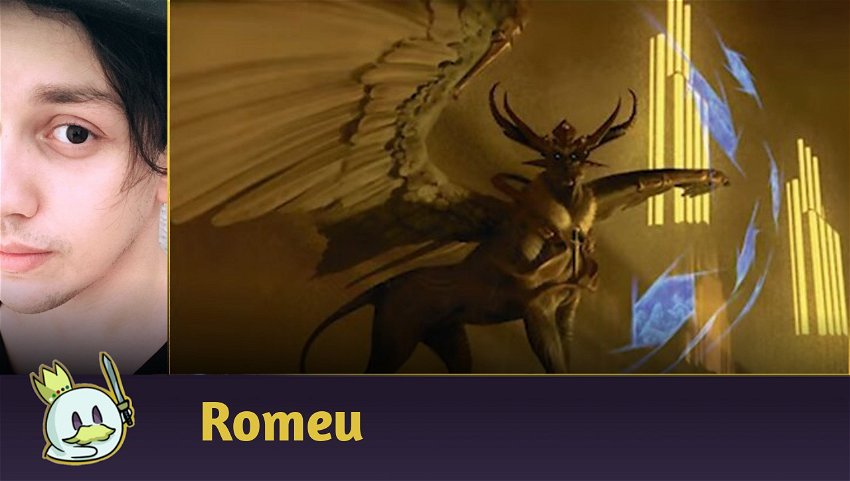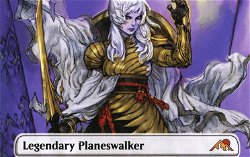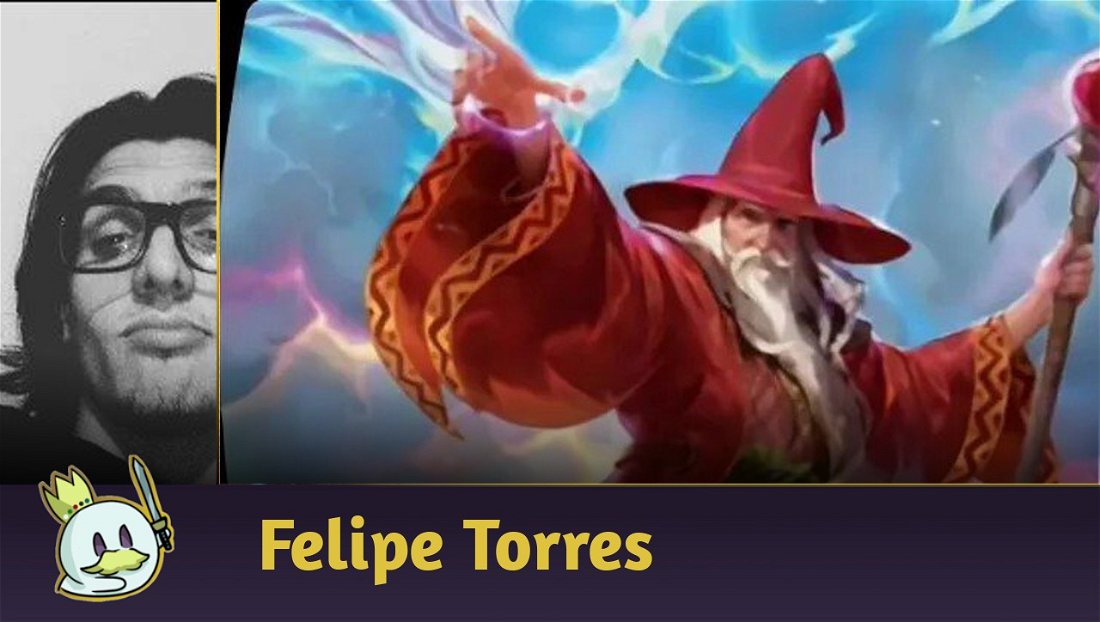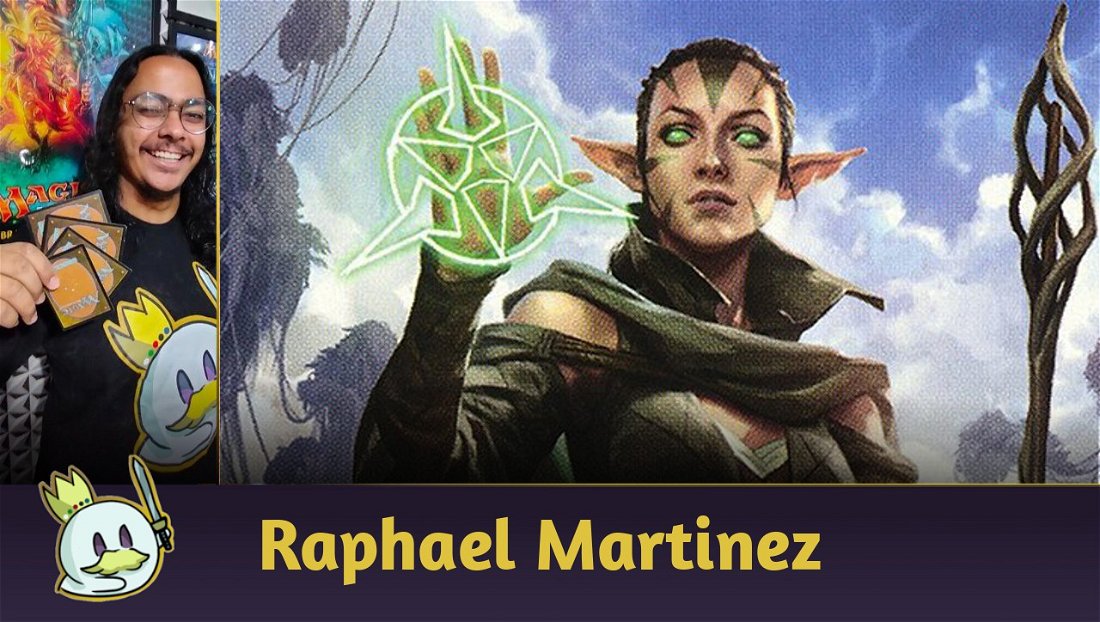It all started when I was asked, after the publication of my last article on Mardu Greasefang, why I considered the Esper version the worst option, as it is much more oriented around the combo than the other variants. My most honest answer is that it's not built efficiently:
If we look carefully, Esper Greasefang has some variants, but they all have similar proposals: to be a Combo-Control that can win the game, from turn 3, while having removals, discards and counterspells to protect the pieces and/or hold the game and with Planeswalkers like Karn, the Great Creator and Tezzeret, Betrayer of Flesh for extra consistency, as well as serving as an alternate means of turning Parhelion II into a creature.
In summary, most Esper lists try to pilot the combo as if it were a Splinter Twin, and while it is compatible in a Combo-Control shell, it doesn't mean it is, in fact, a Splinter Twin because that approach fails miserably to benefit from one of the biggest psychological aspects of Magic, False Tempo.
Greasefang and False Tempo
If you follow my articles, you've probably seen me comment on False Tempo, a term used for when a player makes suboptimal decisions, holds back their resources and misinterprets their role in the game for fear of an opponent's play that could destroy their plans, or win the game on the next turn.
Normally, this happens for a variety of factors, but we can attribute its main characteristic to knowledge and imagination: the hand is, in theory, an invisible and rotating resource, and decklists are not usually so standardized elements to the point that someone can evaluate with absolute certainty every possibility the opponent may have on their list. All we do is consider and assume based on the information we have: available mana, strategy, cards in hand, board position, posture, and yet we commonly wonder if the opponent is just bluffing.
As a consequence, we play around with possibilities as they present themselves: you don't want to attack with all your creatures if your opponent threatens a Settle the Wreckage, but you can make that decision if it suits you, or if you bet they won't have the sweeper.
The same happens when we talk about combos or cards that win the game on their own, as the opponent plays around them and tends to avoid stretching too much and making decisions that lead to the possibility of losing on the next turn, respecting the combo and putting themselves behind in various situations, giving you a few pseudo-Time Walks every turn they choose to be less proactive than they could.
And how should you take advantage of those extra turns you've earned? Capitalizing on them!
There are several examples, but let's focus on Splinter Twin, as we try to emulate the same strategy in Esper Greasefang.
Twin had a strategic advantage against Modern's Metagame at the time, as it took incredibly advantage of the opponent's respect for the vague possibility of you closing the combo at the end of their turn, operating as a pseudo-Control while Snapcaster Mage and Vendilion Clique made it possible to go for the beatdown. All while protecting the combo pieces, interacting with the opponent and punishing them for their conservative decisions.
Several other strategies also do this. Have you ever stopped to think about how many games you've had to put yourself behind because you weren't sure what would happen in the next turn? Orzhov Auras, Boros Heroic, Jeskai Fires, Naya Winota — All of these evoke fear in the opponent and forces them to think twice when making decisions.
Esper Greasefang evokes this same fear in the opponent because they know they must interact with you, especially when there are multiple ways to put Parhelion II in the graveyard at Instant-Speed with Consider, Tainted Indulgence and Faithful Mending. But these versions can't take advantage of this psychological dread, putting themselves in a position where the opponent knows the only thing they need to worry about is dealing with the Combo. The rest is complementary, and exists under the sole guise of speeding up and adding consistency to the execution of your game plan.
Is this a working strategy? Yes!
But Magic is an ever-changing game, and resorting to a combo as a sole plan is often an easy target for most archetypes — interaction is a recurrence in the competitive landscape, and no successful Combo-Control in the last decade has focused integrally on closing it without useful supplementary plans. Even Dimir Inverter could simply win games by casting multiple copies of Inverter of Truth to attack the opponent from the air and set a three-turn clock while still threatening to have a copy of Thassa's Oracle or Jace, Wielder of Mysteries in your hand.
Greasefang doesn't win the game on its own on many occasions. You'll have spent three mana, you probably won't have many resources left, you'll have dealt 13 damage, Parhelion II has returned to your hand, your opponent will untap permanents, and you will have a full turn to win the game, or to clear your board. That's not a problem when you gather the pieces on turn 3. But what about when you gather the pieces on turn 6 because your opponent chose to threaten to kill or counter Greasefang rather than being proactive? What strategic advantage are you taking from this decision?
It was looking for ways to take advantage of False Tempo that I began my search for alternative ways to build Esper Greasefang. My goal was that I could:
1) Create fear in the opponent's head and capitalize on it with my resources.2) Punish them for misinterpreting their role in the match by trying to be the Control when they should be the Beatdown and vice versa.3) Force them to make suboptimal decisions and get punished for them, either for conserving their removals or using them at the wrong time, removing the wrong option with a Thoughtseize, trying to race too much, or not always optimize mana.4) Make common sideboard cards against the combo bad or less useful.5) Be proactive and dictate the pace of the match on my own.And so enters the Obscura.
The Decklist
If you play Standard, you should be pretty familiar with several cards included in this list: Esper Midrange is one of the best decks in the format, and its structure is significantly solid to serve as a benchmark. In fact, this story started while I was watching a certain card do an impressive job at the New Capenna Championship.

Connive is probably the most powerful among the Streets of New Capenna keywords. A looting through an ETB or when casting a certain spell is nothing that we haven't seen in the game before, but when this looting is recurring and comes coupled with a power increase, it allows you to sculpt your hand as needed and takes advantage of any graveyard interactions you may have — The perfect mix for a strategy that wants to reanimate something and win the game, right?
New Capenna brought many decent Connive options to the game, and we don't lack for graveyard interactions in Explorer.
The strategy of this list, therefore, is to act like an aggressive midrange, with decent creatures, interactions, card advantage, and a rising clock coupled with the combo-kill with Greasefang, Okiba Boss and Parhelion II.
Your plan A is to execute the combo, and the Connive creatures and Kaito Shizuki helps you with that plan. We made it a turn slower than any other variant, but the price tends to be worth it, and we can still perform a turn 3 or 4 kill with Raffine's Informant.
Plan B is to be the beatdown, cast creatures from turn 2 and build value with them and attack the opponent from the ground or from the air, while controlling the other side of the battlefield with removals and discards.
Plan C is to extend the game and extract value with Raffine and your Planeswalkers. This usually complements plan B and is what allows us to play longer in more interactive matchups
By complementing your combo strategy, slowing it down and adding Midrange pieces, you force your opponent to make decisions between respecting a combo-kill next turn or having to deal with your attacking creatures, or responding to your Planeswalkers so the late-game doesn't get out of control either — That is, you seek to dictate the course of the match on most occasions, and force them to make decisions, whether good or bad.
Maindeck

The combo parts. Basically, why this deck exists, don't play with less than four pieces of each in the maindeck.

Our enablers that will put Parhelion II in the graveyard.
Raffine's Informant has a great cost for its abilities, serves as a card selection, makes it possible to close the combo on turn 3 and has a decent body that trades with most creatures present in the format if you discard a nonland with its ability.
Ledger Shredder punishes opponents for stretching too much, is an evasive threat that grows quickly in the late game, and is commonly a magnet for removals that could be used on other, more problematic threats.
Raffine, Scheming Seer is the more problematic threat I'm referring to and will typically be neglected until it's too late to mitigate the damage it causes. Connive X sets out a multitude of possibilities, digs absurdly well for combo pieces, and can make any creature a must-answer threat.
Four copies might seem like a lot (and you can cut one if you want to keep the list to 60 cards), but Raffine's own ability makes drawing multiple copies of it or Parhelion II far less punishing.

Scrapheap Scrounger is the best choice I've found for an aggressive, repurposed threat that interacts positively with Connive. Tenacious Underdog is another option worth trying, and I can trade between them eventually, as the New Capenna creature offers a recurring draw, but the lower cost to reanimate and the fact that I can put it on the battlefield at Instant-Speed, in addition to its colorless mana cost that makes it possible to cast on turn 2 without difficulties, made me opt for the Kaladesh's artifact.
You'll see me remove it several times in the Sideboard Guide, and the reasons usually involve the fact that it either gets easily blocked, doesn't interact with my proposal for that particular match, or simply because I didn't have anything better to take away.
Kaito Shizuki is a great Planeswalker as we take advantage of all his abilities: looting can serve to discard Parhelion II, the extra draw helps keep Connive's card selection relevant, and Ninja token cannot be blocked and interacts absurdly well with Raffine.
Finally, despite considering other options that allow extra draws every turn to power Connive (such as Teferi, Hero of Dominaria), The Wandering Emperor is too powerful to be left out and contributes to the aggressive strategy, since it creates more bodies, works as a removal and also as a combat trick, in addition to being able to cast it at Instant-Speed.

Our interaction package has six discards: Thoughtseize and Thought Erasure to ensure we have the information we need to know which stance to adopt while removing an important piece from the opponent's hand. Especially removals or Planeswalkers, which can be difficult to resolve once they enter the battlefield.
Fatal Push is necessary to deal with small creatures from aggressive strategies in the first few turns. It's possible that Bloodchief's Thirst deserves a spot in this slot, but the Instant-Speed makes it possible to better handle some situations and remove larger threats after a chump-block.
Obscura Charm does a bit of everything we want: it allows us to reanimate Greasefang and Raffine on their end step, helps protect our creatures from removals or deal with troublesome spells, and destroys creatures or Planeswalkers with mana value 3 or less, the number ideal for dealing with Greasefang, Okiba Boss, Graveyard Trespasser and Narset, Parter of Veils.

The mana requirements on this list are greedy, and our decisions when playing Pathways can make a crucial difference. I'm still working on it to get the numbers right, but the current composition has worked well so far.
Sideboard

With Mardu Greasefang and Izzet Phoenix being among the top decks in Explorer right now, we need a good number of graveyard interactions to handle these matchups, and each has its advantages and disadvantages over the others.
Graveyard Trespasser doesn't deal with threats on the opponent's turn, but it's a creature with built-in protection and demands that your opponent return your stuff from the graveyard the same turn you put it there.
Unlicensed Hearse removes anything from a graveyard at any moment while also serving as a creature in later stages of the game with a low crew cost, plus, you can reanimate it with Greasefang if necessary.
Go Blank solves a player's graveyard problems only once, but also offers a 2-for-1 trade against the opponent's hand, important for attrition games.

We also need extra interaction against more aggressive archetypes, or to deal with specific threats.
Depopulate is a great choice against Mono Red Aggro, Angels, Gruul and other strategies that need to extend their board to try to win the race before the combo is executed.
Fateful Absence and Vanishing Verse deal with a multitude of problematic permanents, from Planeswalkers and larger creatures, to Rest in Peace.

Dovin's Veto helps us protect the combo in Control matchups and deal with Planeswalkers and other late-game bombs against Midrange or Big Mana without the worry of taking a Mystical Dispute, or another Dovin's Veto in response.
Sorin, Vengeful Bloodlord is an option I've been testing to improve attrition matchups and provide a way to significantly slow down Mono Red and Gruul. Maybe he deserves a Maindeck slot, but I don't like the idea of having too many four-drops and The Wandering Emperor seems like a better choice.
Mulligan and Stances
Mulligan
In this list, there are two types of ideal hands: the combo hand and the fair hand.

The ideal first hand involves having all the combo pieces and the means to interact with the opponent and make sure you can execute it, as well as a combination of lands that allows you to play if you can't cast Greasefang, Okiba Boss on turn 3 because it was discarded, or because the opponent has a counterspell or removal for it, so that nothing you draw in subsequent turns is useless, and you can go for the Midrange route.

The other option involves having a sequence of plays that allows you to start attacking your opponent and cycling your hand with Raffine and other cards with Connive, as they will eventually find the combo or give you more resources.
In general terms, the rules I follow to decide a Keep or Mulligan are:
• Always keep in mind what stance you need to adopt for that particular game, and decide your keep or mulligan based on whether your hand contributes to the proposal you want: it's not worth keeping a Midrange hand when you need to be the Combo.
• Hands that have both combo pieces, three lands and interaction are a keep. You will probably draw something to discard Parhelion II.
• Hands with two copies of Parhelion II can be a keep if you have a way to discard it within the first three turns. That is, anything with Connive or Kaito Shizuki.
• Hands without combo pieces but with an aggressive curve and some interaction, or an aggressive curve and enough mana, are a keep because they allow you to play efficiently while looking for the combo and forcing the opponent to interact with you.
• Avoid having too many 3-drops in your hand: it's okay to have two copies of Raffine if you can drop one of them to Connive, but very heavy hands aren't where you want to be in most games
• The manabase can be a bit tricky, make sure the lands you have can cast everything you have on hand before deciding to keep.
• Any hand without removal or discard and without the entire combo in games that demand interactivity is a Mulligan.
• Hands with The Wandering Emperor aren't usually where we want to be unless the game is really long and the Planeswalker makes a huge difference.
• In case you Mulligan and need to decide between putting Raffine or Kaito Shizuki in the bottom: Raffine is better on the Midrange plan, Kaito is better on the combo plan.
• Don't be afraid to put a combo piece on the bottom after a mulligan if your strategy is going to the Midrange route. You will eventually draw another copy.
Stances
One of the biggest challenges with this version is identifying the ideal posture for what you're playing against.
The starting stance will almost always be to be proactive and cast discard, creatures and seek to put Parhelion II in your graveyard to reanimate it with Greasefang, but you can change your stance completely if your opponent proves to have a better board position or too interactive a stance to blindly try to risk the combo.
To paraphrase one of Bruce Lee's most popular sayings: “Be the water”.
Adapt to the situation and proposal that the opponent seeks and force the match in your favor:
Against Aggro, be interactive, don't be afraid to exchange your creatures in favorable combats and do your best to look for the combo to turn the game around, but if you can deal with their threats, don't be afraid to attack and set up a clock.
Against Control, be the beatdown and use your creatures to pressure the opponent every turn, force them to tapout, to be reactive and don't give them time to be careful with your combo, or force them to over-respect Parhelion II in your graveyard and fail to deal with what you have on the board until it's too late.
Against Combo, propose an interactive and fast game, avoid spending turns doing nothing relevant and know how to identify which pieces are punctual for the execution of your opponent's plan, or which pieces must be removed to speed you up.
Against Midrange, adapt to the situation, play the fair game, make favorable trades and leave the combo as an auxiliary plan while the match unfolds around the other resources.
Tips and Tricks
• Remember that you must crew Parhelion II before the declare attackers phase, or it won't be a creature.
• In this list, Greasefang may occasionally be just a 4/3 creature to improve your board position and/or work as a removal magnet.
• Remember that Ledger Shredder counts any player's second spell. This is important if you can cast two spells in a single turn, as it allows you to play it first and then cast the second spell to trigger Connive.
• Scrapheap Scrounger can be returned from the graveyard at Instant-Speed, you can respond to some exile effect like Graveyard Trespasser by reanimating it.
• Obscura Charm brings a multicolored permanent from the graveyard to the battlefield. That is, it can also return Kaito Shizuki.
• Obscura Charm brings the permanent onto the battlefield tapped. So, you can't use it in your main phase to perform the combo if you don't have other creatures to crew Parhelion II.
• Speaking of which, you can reanimate Scrapheap Scrounger before attackers are declared to help crew Parhelion II in case the opponent kills Greasefang, Okiba Boss after its trigger goes on the stack.
• Although these occasions are rare, you can target yourself with Thoughtseize to discard Parhelion II and then perform the combo with Greasefang, Okiba Boss.
• If the opponent has Graveyard Trespasser on the battlefield, one way I've found to perform the combo without slowing it down too much is to first cast Greasefang and, if he survives, discard Parhelion II on the next turn.
• Kaito Shizuki only discards cards if you haven't attacked with a creature this turn. Keep this in mind before entering the combat phase.
• Raffine, Scheming Seer has Ward 1, this is a critical point when considering what interactions the opponent can have against it in the End Step (there are times when opponents themselves forget about this ability).
• Raffine's trigger, when attacking along with Parhelion II, must be put on the stack to resolve after the creation of Angel tokens: they will count as attacking creatures, and you will draw two more cards with Connive.
• The only color that requires two colored mana to cast a spell on this list, both on the maindeck and on the sideboard, is white. Your initial focus with Pathways should be to establish one mana of each color. Then, choose to have two white mana available, then two black mana, and finally, two blue mana.
• Takenuma, Abandoned Mire mills three cards and can return Planeswalkers. Sometimes it's worth risking its activation to dig deeper for the combo and, if you can't find it, return Raffine or some Planeswalker to your hand.
• When cast, The Wandering Emperor can activate its abilities as if it had Flash. This makes possible a number of little tricks, like increasing power and giving First Strike to a creature so that it doesn't die, or exile an attacking creature, creating a token to help crew Parhelion II, etc.
Sideboard Guide
Mardu Greasefang
IN:

OUT:

The match against the Mardu variant boils down, in Game 1, to players trying to make the combo before the opponent, but we have some advantages compared to the other side: our alternative game plan is more efficient than theirs, and we have more ways to interact with Greasefang, Okiba Boss, so don't try to rush too much and be proactive while the opponent doesn't have a Parhelion II in the graveyard, but respect the possibility of them having the combo on hand in the first few turns.
Post-Sideboard, we have an edge as we add plenty of interactions for every game plan the opponent might adopt, while removing bad blockers or cards that lose their usefulness in longer games.
Rakdos Midrange
IN:

OUT:

The match against Rakdos Midrange is balanced in Game 1, but it became disastrous post-sideboard every time I chose to keep the combo because it has an abundance of answers for any occasion where I try to close it on both maindeck and sideboard, and only a combination of well-placed discards and a fast kill really justify keeping it.
As this proposal is too conditional, I chose to go the Midrange route and improve my fair game, removing all the pieces and a copy of Thoughtseize, for being a bad topdeck.
We add all of our answers against the most varied matchups, which end up transforming our list into a complete Esper Midrange, capable of dealing with different situations throughout the game and making their sideboard hate much less efficient against us, while we gain fewer useless cards.
This is not an easy game because, like any game of attrition, we need to decide well what we want to remove and when we want it. Don't be afraid to exchange some creatures in combat if it prevents a snowball, and remember that victory will likely come through the combination of Raffine and Planeswalkers.
Izzet Phoenix
IN:

OUT:

Since we have good flying blockers and exile effects in the Maindeck, in addition to an efficient clock, the matchup against Izzet Phoenix becomes well-balanced and even vaguely favorable as long as the opponent isn't putting many birds on the board every turn.
Fortunately, Raffine, Scheming Seer and Ledger Shredder only need one Connive trigger to kill Arclight Phoenix in combat. Because of this, our focus should be on chasing the combo while holding the game or trying to be aggressive against an empty board. Just be careful not to lower your life too much.
Post-Sideboard, we removed our discards as they are bad against Izzet Phoenix, while Kaito Shizuki is not exactly what we want to cast for three mana in a game that involves Mystical Dispute and Play With Fire on the other side, and we make room for eight direct interactions against the opponent's strategy, but which also offer additional effects such as disruption or extra threats.
Our best post-sideboard route is still to go after the combo and close the game quickly, but we can operate on a fair game while dealing with additional threats like Crackling Drake.
I emphasize that some lists run Brazen Borrower between the maindeck and the sideboard, and it is necessary to respect this possibility when executing the combo.
Azorius Control
IN:

OUT:

Game 1 against Azorius Control is relatively good because our initial plan is beatdown, where we pressure them to respond to our threats while, at some point, we present the possibility of closing the combo. In addition, we can also extract a lot of value from our Planeswalkers and Obscura Charm in this game, but try to keep their Planeswalkers out of the battlefield.
Post-Sideboard, we need to focus less on the combo since we will probably face Rest in Peace, and we want to have fewer dead cards to be able to operate well in the late game, but without giving up Greasefang and Parhelion II entirely because we still have plenty of opportunities to close the game with them, while we force our opponent to stretch, or when we have a good backup.
We've added more interaction, in addition to Graveyard Trespasser as a threat that forces a 2-for-1 to be removed and punishes the "draw go" strategy.
Mono Red Aggro
IN:

OUT:

The match against Mono Red is unfavorable because we didn't prepare enough for it, as I haven't seen that many Mono Red in Best of 3 recently. So, our best option in Game 1 is to make favorable trades with our creatures and slow down the clock while we try to execute the combo. If this goes wrong, we lose the game, it's not worth being the beatdown.
Post-Sideboard, we remove all the bad cards for this match and put more direct interaction and our best anti-race tech, Sorin, Imperious Bloodlord.
Our plan will still involve trying to close the combo quickly, but we can go aggro if the board stabilizes, or if we cast Sorin early and start to gain life every turn.
My best tip, however, is to try to keep the battlefield clean and force the opponent to swap their damage spells on your creatures. Don't be afraid to cast Ledger Shredder at 2 to "eat" a Lightning Strike or Wizard's Lightning, these mini-swaps will make a difference in the long run.
Mono Blue Spirits
IN:

OUT:

Despite playing few games against it, I suppose the matchup against Mono Blue is unfavorable since it does everything at Instant-Speed and our main plays are at Sorcery-Speed.
Post-Sideboard, we removed discards because they are awful against flash threats, as well as Kaito Shizuki, which forces us to pay three mana for a low-impact play against a Tempo Deck.
The best proposal I found in this game was to try to force Mono Blue to reach out and respond to creatures on their turn, avoiding positive Tempo trades and forcing a tapout to then clear the board with Depopulate and then start to recover.
Jeskai/Four-Color Fires
IN:

OUT:

Fires is a match where both are trying to make their absurd thing before the other, except that some versions manage to close the combo on turn 3, while others look to extend the game.
Here, we need to speed up our combo as we try to interact with the opponent through discard and removal, as well as constantly keeping Narset, Parter of Veils out of the battlefield.
Post-Sideboard, the match remains balanced and our main plan is still to close the combo, but we have better options to deal with it. This is also the only match where we remove Raffine, Scheming Seer for his destructive potential when Narset is in play.
Four-Color Ultimatum
IN:

OUT:

Four-Color Ultimatum is a Big Mana deck geared towards casting bombs in Late-Game, from Genesis Ultimatum to Ugin, the Spirit Dragon and even Ulamog, the Ceaseless Hunger, while taking out an absurd advantage of the Lotus Cobra and Omnath, Locus of Creation triggers.
We're too interactive in Game 1 for their proposal, so any plan that involves a fast clock and discard will be enough to delay the opponent for enough turns until we can close the combo, preferably performing a one-turn kill, as long as we use our spells to deal with the pieces that really matter: Escape to the Wilds and Genesis Ultimatum.
Post-Side, we've added more interaction with larger creatures and Planeswalkers, as well as counterspells and Go Blank, which offers a relevant 2-for-1 for a list that tends to empty the hand quickly without Escape to the Wilds , while removing Scrapheap Scrounger, as it is easily blocked by Omnath or Arboreal Grazer while doesn't support our combo plan, and Fatal Push for not dealing with most of the opponent's creatures.
Golgari Stompy
IN:

OUT:

Golgari Stompy has appeared regularly in recent weeks, both in the classic version, with Collected Company, and in the more recent one that runs Fight Rigging to cast stuff without paying the mana cost. It's not a favorable game in Game 1 since we have few answers if they start the game explosively with Rotting Regisaur followed by Ghalta, Primal Hunger, and not to mention that some lists have Scavenging Ooze and Thoughtseize on the maindeck.
Post-Sideboard, I believe the game is balanced since we add more direct interaction with the battlefield, and we were able to control the game while our creatures attack from the air and our combo is not as easily responded to if we keep Scavenging Ooze out of the board.
Gruul Aggro
IN:

OUT:

If the opponent is in the version with Burning-Tree Emissary, Zhur-Taa Goblin and Gruul Spellbreaker, you can replace Vanishing Verse with Go Blank to try to zero out its late-game features and get it to topdeck mode sooner, but I haven't tried that approach in many games to say if it's really effective.
Gruul Stompy is another race game where our only option is to hold the game with blockers and removals while looking to dig for the combo as soon as possible, and we need to try to keep the board empty to prevent the opponent from casting Embercleave too soon.
Post-Sideboard, you assume the “combo-control” stance, as you do in other aggressive matchups, trying to close the combo while favorably blocking with your creatures and/or forcing the opponent to extend and be an easy target for Depopulate.
Selesnya Angels
IN:

OUT:

Selesnya Angels is a bad match pre-sideboard because our combo is ineffective for a list that gains an absurd amount of life quickly, we have too few board interaction and where all their creatures fly. Our best option is usually to try to make the combo work fast, but normally, we will lose Game 1 because our damage, even after attacking with Parhelion II, won't be enough and/or will be easily mitigated by their lifegain.
Post-Sideboard, we've improved the game with more removals and Angels have a natural weakness to sweepers and a bad topdeck, so we can hold the game and deplete their resources before going proactive.
However, we need to be cautious with Collected Company and/or with effects that protect creatures, like Guardian of Faith, and the reason I add Go Blank in this game is precisely to force them to be more proactive with their spells and extract more value from sweepers.
Sacrifice
IN:

OUT:

Sacrifice is a balanced game in Game 1, but it can get out of hand if they find all the pieces to start the Cat-Oven and Mayhem Devil loop, so our priority is to keep those cards out of the battlefield. The Midrange route will usually be the best choice early in the game because they will usually have Thoughtseize on the first few turns, but the combo shouldn't be overlooked.
In Game 2, we removed all parts that interact poorly with this match: Kaito and his token can be easily resolved by Mayhem Devil, Scrapheap Scrounger is an easy chump block, and Fatal Push has few important targets, while the graveyard hate we bring is essential to prevent looping and/or to exile Kroxa in the Rakdos version.
Your plan should still be to play Midrange without disregarding the combo. The Jund version can be more complicated if the opponent casts a Korvold, Fae-Cursed King, so try to direct your discards towards anything that allows them to generate value with sacrifices.
Conclusion
That's all I have to share about Obscura Greasefang.
I've been piloting this list for the past few weeks, and it has delivered impressive results in Best of 3, but I'm not claiming it's superior to the Mardu version in Best of 1 because that one or two turn delay makes a much bigger difference in a world without sideboards.
That said, I definitely recommend anyone to play with this version and learn how to get the most out of it, and we can share experiences and ideas to improve its base.
If you have any questions, I'll be available in the comments.
Thanks for reading!














— Comments 0
, Reactions 1
Be the first to comment